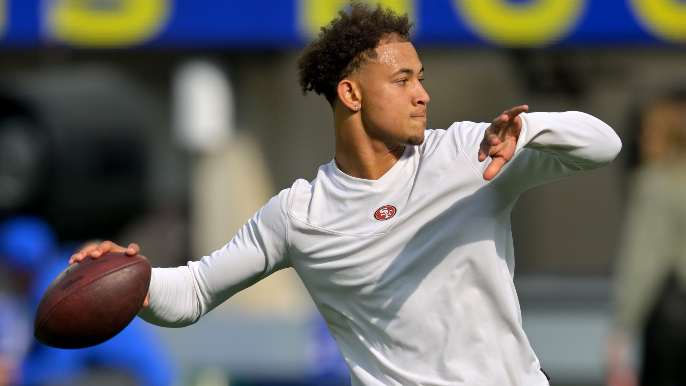
Trey Lance’s path to recovery was extended on Friday. The 49ers announced that Lance underwent a second surgery on his right ankle in order to remove hardware that was causing irritation.
It’s a less than satisfactory conclusion to a brutal 2022 for Lance. The following is the 49ers’ statement on the surgery:
San Francisco 49ers quarterback Trey Lance underwent successful surgery on his right ankle yesterday. The second procedure was performed to remove hardware that was inserted during the initial surgery in September.
Due to the location of the fracture, the required hardware placement was close to a tendon in Lance’s ankle. During the rehab process, their close proximity proved to cause irritation in his ankle. After consulting with multiple experts, the decision was made to have the hardware removed to prevent future issues in the ankle.
Lance will continue his rehab process and is expected to make a full recovery and return for OTA’s.
The initial surgery Lance underwent on September 19 at Stanford Hospital repaired a fibula fracture and ligament disruption.
It can be difficult to know what to make of this. Lance was expected to return for the start of OTAs and there is every indication that remains the case. He has an abundance of time to recover, and after an expected two weeks on crutches after this surgery, will return to the rehab process.
The question is more about whether this complicates his recovery or the long-term stability and health of his ankle.
That will become apparent over time, but the particular surgery Lance had this week is not uncommon for the injury he had. Hardware is typically installed to assist the healing of bones, but pain and discomfort can result in the ankle.
While there doesn’t appear to be an abundance of research specifically relating to the fibula fracture and ligament disruption Lance sustained, there are studies on the results of general hardware removal and removal in the case of tibia fractures.
A 2016 study in Biomed Research International assessing ankle fracture repairs assessed whether hardware removal was recommended.
The study found that 80.8 percent of patients were satisfied with removal; 72.5 percent had improved ankle stiffness and 81.3 percent had less discomfort when walking on uneven ground. While the study identifies limitations in its process, it concludes that hardware removal should be recommended:
“Our results of hardware removal after ORIF for an ankle or distal tibia fracture, even in mild symptoms, improve the functional daily activities in the patients’ perspective and high patient satisfaction, supporting the recommendation to routinely remove hardware from these patients.”
A 2015 study in BMC surgery reported that “96 percent of all patients, and even 66 percent of the patients who subjectively perceived complications after hardware removal would opt for surgical implant removal again.”
Again, there’s not an abundance of data on the subject, and both studies suggest further research, but both also reported a very high rate of patient satisfaction with hardware removal.
A second surgery is of definite concern, but Lance’s is fairly common, has a quick recovery time, and has a high rate of reported satisfaction, per the limited, available research.

